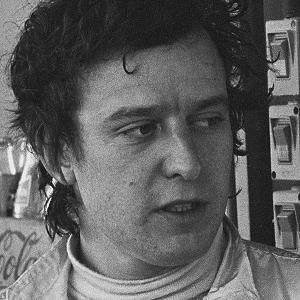The man who replaced Jim Clark: How Jackie Oliver winged it
The Lotus 49 is your favourite car of the past 100 years but it wasn’t all plain sailing. Jackie Oliver tells Damien Smith about his own experiences

Getty Images
The greatest racing car? Jackie Oliver is not about to argue with Motor Sport readers, especially given the role the Lotus 49 played in his own racing life. “It’s a very important car in my career,” says the 81-year-old. He was 25 when he took his Formula 1 bow in a 49 – thrown into a maelstrom in place of Jimmy Clark, lost a month earlier in a Formula 2 race. As rookie accounts go, Oliver’s takes some beating…
“The 49 was one of the first F1 cars I drove, before Jimmy went to Zandvoort with it,” Jackie Oliver says. Having first shown his hand in a Lotus Elan 26R, Oliver had been signed to Lotus Components as the mid-1960s equivalent of a reserve driver, racing in Formula 3 and F2 in tandem with a vital test-driver role for Colin Chapman’s latest creations. “I drove everything that Colin threw at me, mostly at Snetterton, sometimes at Hethel. And the 49 broke this knuckle,” he adds, pointing at his right hand.
Oliver was a passenger in the inauspicious start to his relationship with the 49. “Team manager Jim Endruweit, who was a fan of mine, said, ‘We haven’t run the car before, I’m waiting for Graham [Hill] to turn up, just do a shakedown,’” he recalls. “So I drove out very steadily, down the Snetterton straight which was a lot longer than it is now, put the brakes on at the end and my knuckles smashed into the instruments. No steering.
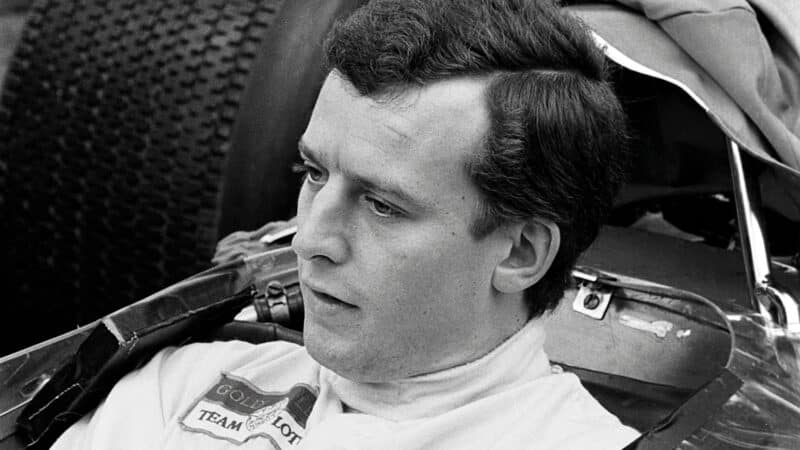
Jackie Oliver was known as ‘Jack’ until Lotus’s ‘rebranding’ at the 1968 Monaco Grand Prix
Getty Images
“They came out to rescue me and when I explained what happened they said, ‘Ah, we wondered about that.’ ‘What do you mean?’ Turns out Colin wanted two tubes [for the steering column], one inside the other, because Jimmy and Graham were different sizes and he adjusted it with a series of holes between the larger and smaller tube, using a 1BA bolt to save weight. When I leant on it at the end of the straight it snapped the bolt.”
A prime example, right there, why Jackie Stewart avoided Lotus and put his trust instead in Ken Tyrrell. “It was also what made Colin great,” Oliver quickly points out.
Big history followed that setback, of course. At Zandvoort, Team Lotus unveiled the purposeful 49, bristling with its new Ford Cosworth DFV V8 bolted directly to its monocoque chassis, and Clark won first time out. But only after the DFV in the sister car driven by Hill – back at the team where it had all started for him in the 1950s – had broken while leading. That proved a crucial pointer in how the rest of the 49’s first season turned out, Lotus-Cosworth frailty scotching Clark’s world title hopes. No one will ever claim the 49 was perfect. Although Oliver knew from the start how good it was, despite the painful state of his knuckle.
“Speed and the stopwatch tells you everything you need to know. But the feeling through a driver’s bum and your hands on the steering wheel tells you how much grip the car had. A driver doesn’t experience speed, he experiences grip, and the more grip a car’s got the quicker it’s going to go. You feel it, as soon as you get in. When I first drove the 49 at Snetterton the car had grip, and when you stuck a wing on it, it had even more. And it was the lightest car because of its monocoque structure, with the most powerful engine bolted directly to it as a stressed member.”

Jim Clark gave the 49 a win on its debut in the 1967 Dutch Grand Prix – the first of four victories that season
By 1968, the honed 49B was at its zenith. Clark won easily, in lurid Gold Leaf colours for the first time, in South Africa on New Year’s Day, with Hill making it a Team Lotus 1-2. But by the time the world championship resumed in Spain on May 12 Lotus was reeling, in a state of profound grief. Still, somehow Hill kept the flame burning, inheriting victory at Jarama when Chris Amon’s Ferrari let him down. At Monaco at the end of the month Graham won again, the fourth of his personal tally of five in the principality (the last following a year later, also in a 49). By now Chapman had been convinced to replace the irreplaceable.
“I got a rowing boat to the pits and Colin was sitting there with his lap chart: ‘You’re fired’”
“Colin had just lost his best friend and best driver,” says Oliver. “Jim Endruweit said to him, ‘The season has already started, Jackie knows the car, I’ve seen all the work he does, I think you want to stick him in.’ Given the bereavement the team was going through, it was a baptism of fire. My first race was Monte Carlo which I’d never been to before,” – he chuckles at the memory – “so you start to see the issue. After the start [Ludovico] Scarfiotti and Bruce [McLaren] collected each other coming out of the tunnel and when I arrived it was either the harbour – and I’m not a good swimmer – or barrier. So I wiped off two wheels in the accident. I got a rowing boat to the pits and Colin was sitting there with his lap chart. He said: ‘You’re fired.’”
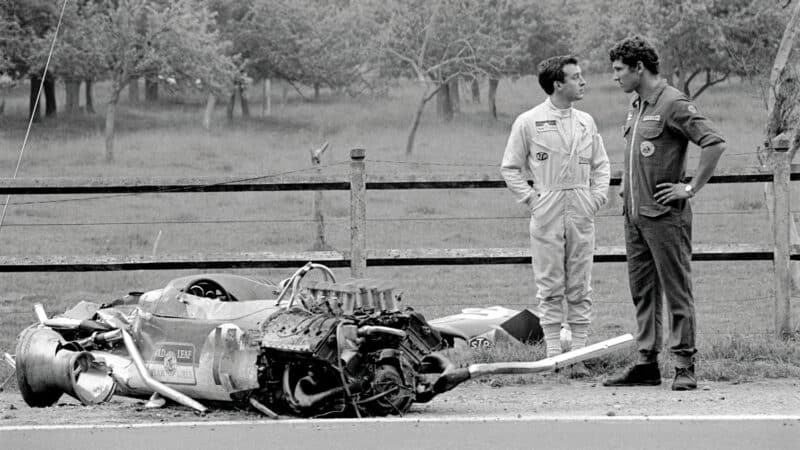
Oliver, left, rode his luck at Rouen in 1968 – he walked away from this crash in Colin Chapman’s winged 49B
LAT Images
Chapman could be brutal with drivers, even when he wasn’t racked with grief. “The only instruction I got from Colin? He stuck his head in the cockpit before the start and said, ‘Lad, never more than six cars finish this race.’ I didn’t know what he was talking about. What he was trying to say, and he should have sat me down before, was, ‘Look, we’ve dumped you in this, just take it easy and if you finish you’ll get your first world championship point.’ But Colin didn’t do things like that.”
The 49, like every F1 Lotus, existed in a constant state of evolution through its racing life. At Monaco the 49B had sprouted an upswept engine cowl with a NACA duct feeding air to the gearbox oil cooler. Next time out at Spa Brabham and Ferrari experimented with strutted aerofoils and balancing vanes on the nose. Chapman wasn’t there yet.
“Colin stuck with the swept engine cover, which I suspect wasn’t very efficient,” says Oliver, who as it turned out hadn’t been fired – but didn’t have a car to drive until the Saturday. “Also we were having a lot of trouble with the joints on the rear driveshafts which were fragile. Colin came up with a constant velocity joint and it worked well. It had no vibration, was smooth and I was quick in the wet, one of only a few drivers to go out on the Saturday. In the race the constant velocity joints packed up. I could hear them. I came in and Colin stuck his head in the car. He said, ‘Take it easy on the last lap,’ but they didn’t last. I was classified fifth but only because nobody else finished. Bruce won in his McLaren because it was the most reliable car.”
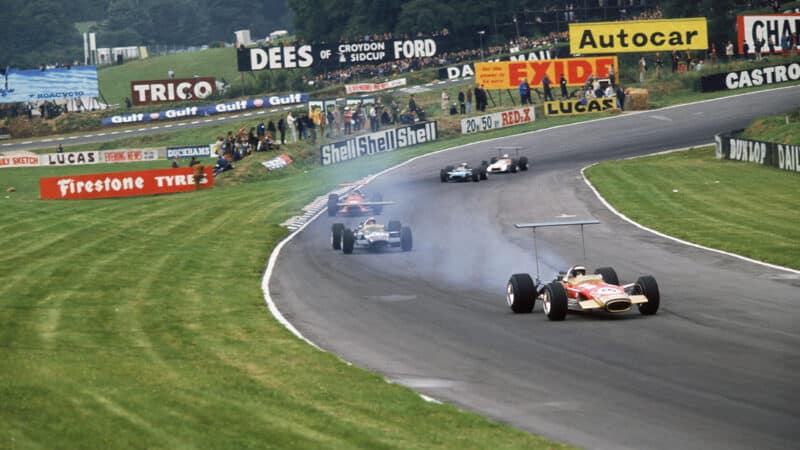
Smoke pours from Oliver’s 49 in the 1968 British GP, the result of a mechanic’s error
Getty Images
At a wet Zandvoort, Oliver was thwarted by water in the electrics, the 49 having sprouted a tacked-on aluminium spoiler to the trailing edge of its engine cowl. Next stop, Rouen, where Chapman introduced his own strutted aerofoils – and Oliver found himself back in the wars. “That race nearly killed me,” he states. “Lotus turned up with its high wing. I looked at Graham’s car and asked why mine was higher than his? Colin said, ‘We’re trying to work out where the less turbulence is. The higher up, the less there should be for downforce.’ I was standing horizontal to the car, next to these big struts on the uprights and pushed across them.” Jackie makes a vibrating noise. “They went wom, wom, wom. ‘Is that all right?’ ‘Lad,’ he said, ‘when you take off in a Boeing 707 and look out the windows the wings flap so they don’t break.’ OK, fine. But of course what happened is the struts did this behind the wake of Dickie Attwood’s BRM. As I came past the pits Dickie moved over and as I switched over I think the struts collapsed. I don’t know for certain because we didn’t have cameras everywhere like we do today. It sent me over to the château wall.”
“It was a fragile car which won the championship with Graham”
Photos of an ashen and bemused Oliver standing beside his wrecked 49B are perhaps the defining images of his first season at the pinnacle. He remains full of admiration for Chapman and his 49, while also nodding towards the stress Team Lotus drivers faced with the way the ‘Old Man’ operated. “It was the best car in F1 and the reason why was Colin and his tools for new inventions – [which were fitted] at the race track before the race. We never ran that high wing at Snetterton. Rouen was a high-speed circuit so Colin said, ‘Let’s put a wing on.’ It produced a fragile car which won the championship with Graham, of which I played a small part.”
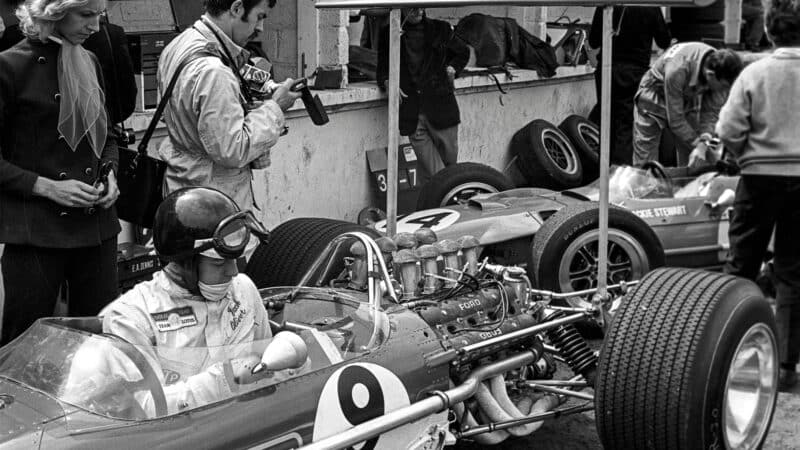
On a wing and a prayer in the Brands pit
Getty Images
His F1 day of days followed at Brands Hatch, where Oliver should have won the British GP. “I was fully confident because it was a circuit I grew up with,” he says. “I was at the best circuit in the best car in F1.”
Oliver led Hill from the start, before the Lotus team leader hit the front – only for a broken driveshaft and suspension to thwart another bid for Graham to win his home GP. Now it was Oliver’s to lose – but it was the 49 that lost it for him, when early oil smoke returned, this time terminally. At least the Team Lotus double failure opened the door for another 49, that of Jo Siffert, to score an emotional first points-scoring GP victory for Rob Walker since the days of Stirling Moss.

Oliver was ‘fired’ after crashing at Monaco
Getty Images
“I should have won that race,” says Oliver. “Why didn’t I? I asked Colin afterwards, ‘What went wrong?’ It wasn’t the gearbox seizing as he thought, it was the engine. So I went to a mechanic and asked why. He said Colin’s solution to the breathing problem the Cosworth had was to put a breather pipe in a little can attached to the back of the gearbox, so the oil mist would collect in there. We had a little electric motor that ran windscreen wipers on road cars to pump it back into the dry sump. And the mechanic put the plastic pipe on the wrong side of the exhaust system! So it burnt through on the first lap and you could see that from all the smoke I was trailing on to Graham’s visor. It lost so much oil it ended up surging and that did the damage. Colin was all about Heath Robinson solutions.”
But the Brands performance stood Oliver in good stead. Clearly unloved by Chapman, soon he would agree a deal with Louis Stanley to join BRM for 1969. “Colin didn’t want me as a driver,” Oliver states flatly. “I kept on calling Colin ‘Sir’. He didn’t want to be superior to me, he just wanted the driver to tell him what he needed to do to make the car better. I just got the view that he knew he had the best car and wanted the best driver – and I wasn’t that person. After the British GP I had a lot of teams contact me to ask if I’d join them. Louis Stanley was one. I think Colin knew that and he thought, ‘Do I offer this young guy a contract for 1969 or do I get Jochen Rindt?’ As far as Colin was concerned the decision was easy. He probably knew I was going after BRM. Stanley was all over me like a wet rag.”
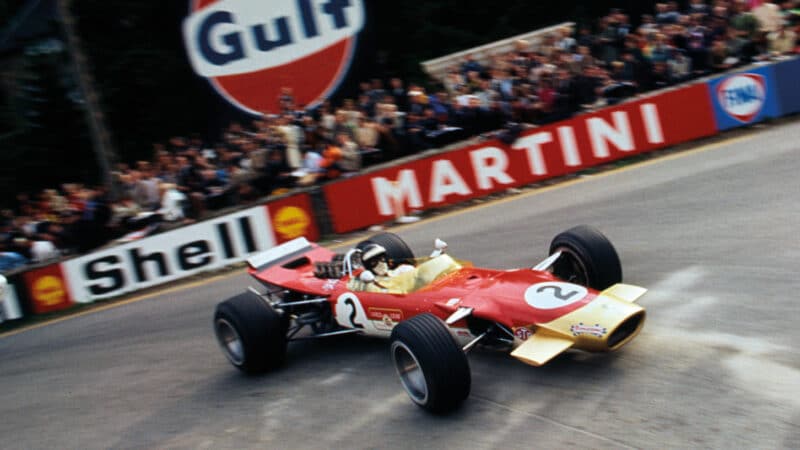
The 49 almost lasted the full distance for Oliver in the 1968 Belgian GP.
Getty Images
There’s another sidenote to the tricky relationship with Chapman and how it left a mark on Oliver: it changed his name. “I was Jack Oliver up to F2,” he says. “When I turned up in Monte Carlo for my F1 debut there was a press release and I said to Jim Endruweit, ‘What’s this Jackie? He said Colin had been trying to get Jackie Stewart out of Tyrrell, but Tyrrell wouldn’t release him.” So Jack Oliver became Jackie Oliver through a misprint, and only because he wasn’t Jackie Stewart? “True story. That’s how I became Jackie. All my old friends still call me Jack.”
A silver lining to a turbulent year emerged at his final race with Team Lotus, in Mexico City. As Hill took the victory that would crown him a two-time world champion, having admirably hauled Lotus back from the depths of despair, Oliver finished third for his first F1 podium. With hindsight, what did he learn from driving for Chapman?
“I became much more assertive, especially after being teamed with John Surtees in 1969 and seeing his undiplomatic manner in how he dealt with Stanley. In 1970, my second year at BRM, I told Stanley exactly what and who he needed to change. I told him he should look for a different team manager. I was right, because Tim Parnell wasn’t his father. Stanley phoned me the next day and said, ‘We are not going to renew your contract because you don’t have the faith in the people that I do.’ So I went to McLaren for 1971.” Another lesson? “Being assertive in a team, how you do it and whether it is receivable is the key question. Easy looking back, isn’t it?”
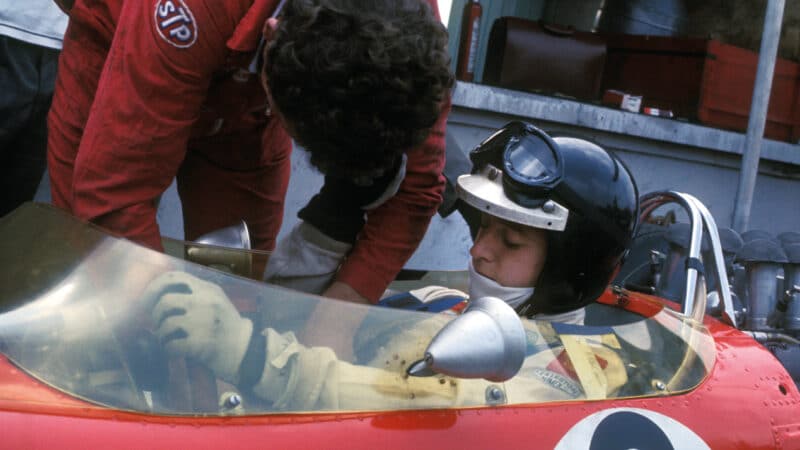
The race Oliver should have won – the 1968 British GP at Brand Hatch
Grand Prix Photo
For Oliver, the most directly applicable legacy of his time in the 49 was that early experience of the Cosworth DFV, the engine that would dominate a decade and allow him to create his own team, Arrows – just as it did for so many others with such ambition. “A V8 for a modern race car offers a great combination of power curve and revs, so it’s not surprising Keith [Duckworth] ended up having a combination with fuel injection that was dominant,” he says. “V12s were a Ferrari passion, but for the extra revs you didn’t get a better power curve and you carried a bit more weight. The DFVs enabled F1 to have a lot of garagistes. I was eventually one!”
